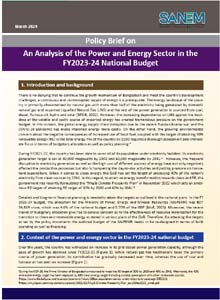
COVID -19 Fallout on Poverty and Livelihoods in Bangladesh: Results from SANEM’s Nation-wide Household Survey (November-December 2020)
 Citation: Raihan, S., Uddin, M., Ahmed, M.T., Nahar, M.A., & Sharmin, E. (2021). COVID -19 Fallout on Poverty and Livelihoods in Bangladesh: Results from SANEM’s Nation-wide Household Survey (November-December 2020). SANEM Publications, Dhaka, Bangladesh.
Citation: Raihan, S., Uddin, M., Ahmed, M.T., Nahar, M.A., & Sharmin, E. (2021). COVID -19 Fallout on Poverty and Livelihoods in Bangladesh: Results from SANEM’s Nation-wide Household Survey (November-December 2020). SANEM Publications, Dhaka, Bangladesh.
Until the onset of COVID-19 in March 2020, Bangladesh made an impressive reduction in the poverty rate from as high as 56.7% in 1991-92 to 20.5% in 2019. Despite this remarkable alleviation, most of the people who graduated remained close to the poverty line income – thus remained as the vulnerable poor. In the pre-pandemic situation, nearly half of the population in the country were within the threshold of vulnerable poverty. Given this context, any major economic shock, such as the COVID-19 pandemic, is obvious to leave dents on the progress achieved in alleviating poverty over the past decades. A thorough assessment is warranted to tackle the pandemic’s multi-dimensional ramifications on the economy, particularly on Poverty, Inequality, and Employment (PIE). Understanding the dynamics of PIE in the pre-COVID and the post-COVID situation is critical to achieving inclusive economic growth as per the agenda of the SDGs, the 8th Five Year Plan (8FYP), and the Perspective Plan.
In this regard, SANEM conducts a nationwide survey in November-December 2020. The 2020 survey is built on a survey conducted by SANEM-GED in 2018. SANEM, in collaboration with the General Economic Division (GED) Planning Commission, conducted a nationally representative survey of 10,500 households in 2018. To understand the COVID-19 impact at the household level, SANEM attempted to reach all 10,500 households from the 2018 survey. Given the ongoing pandemic situation, SANEM surveyed over the phone in November-December 2020. Among the 10,500 households, SANEM successfully interviewed 5,577 households from 500 Primary Sampling Units (PSUs) distributed across eight divisions and 64 districts. A comparison between the pre and post-COVID scenario for these 5,577 households are analysed. The study presents findings on PIE, and come up with some insightful policy recommendations.



